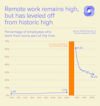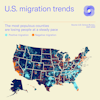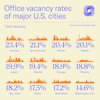The workplace is changing rapidly as… American workforce. For many workers today, their physical work environment is no longer limited by in-person presence, corporate headquarters, or crowded cities.
On the other hand, Americans' share of the labor force is shrinking, resulting in employers needing to compete for remote talent; The cost of living is rising, stimulating the phenomenon of urban-to-rural migration; Many office spaces remain vacant, which is stimulating an economic chain in American cities.
Here we examine the evolving dynamics of America's workplaces and share insights into what companies need to know.
The past, present and future of remote work
According to data from the National Bureau of Economic Research, remote work peaked amid the peak of the COVID-19 pandemic in 2020 and 2021. Although remote work has declined significantly since then, workers' preference for flexibility in the workplace remains.
In 2023, only a quarter of employees were working remotely part of the time. While this is a small number compared to the pandemic spike, it is still higher than the pre-pandemic rate, indicating the continuity of some remote work in the coming years.

Likewise, the latest A special report on the workforce issued by RSM and the U.S. Chamber of Commerce It found that the percentage of middle market companies reporting having employees in remote or hybrid arrangements fell to 27% from about 36% a year ago, but the report notes that the current share reflects a normalization of that trend.
Additionally, 60% of mid-market survey respondents said flexible work models have positively impacted their organization's culture, a significant increase from 39% a year ago.
Before 2020, work was remote Unfamiliar.
-
6%
Workers in metro areas who worked remotely in 2019
-
5%
Workers outside metro areas who worked remotely in 2019
Enhancing an employee's ability to work and learn from home over the past decade is the increasing prevalence of Wi-Fi. Percentage of individuals who have Wi-Fi service at home It has grown significantlyfrom 72% in 2010 to 87% in 2019. The penetration of Wi-Fi at home has continued to grow over the past three years, reaching 92% in 2023.
While remote work remains popular for those who have the option to do so, there are industries that need employees in person to work. The hospitality, food service, transportation, and retail industries have the highest propensity for in-person work.

Instead, industries that require less physical labor or customer service tasks are more likely to have the option of remote work — or allow employees to remain entirely remote — as is the case in the information and finance sectors.
Immigration of American workers
The normalization of remote employee work over the past several years coincides at least part of the time with another trend: the migration of people out of American cities. According to the U.S. Census Bureau, over the past two decades, Americans have been moving out of major cities, while populations in other areas have been growing.
-
New York City, Bay Area, Chicago
Places from which Americans left
-
Orlando, Tallahassee, Charlotte
Places Americans moved to

The South gained the most people from interregional migration in 2021, while the Northeast lost the most people. The South may have attracted more people due to lower costs of living, a warmer climate, and a diversified economy, while the Northeast may have lost people due to higher costs of living, cold weather, and dense cities.
While more people moved from most parts of the United States Famous cities Instead of moving in, cities won't turn into ghost towns anytime soon. As migration trends continue, cities will have to address the changing needs and desires of communities to retain residents and attract new ones.
according to US Census Bureau, 53.5% of participants who moved in 2022 stayed in the same county, and only 17% moved to a completely new state. Reasons for moving across state and county boundaries vary across regions and groups.
Americans have moved for various reasons over the past few years, but most… Common causes Americans' decision to move in 2022 was to upgrade housing, start a new family, and start or move to a new job.
-
42%
Movers are driven by housing in 2022
-
27%
Family Motivated Movers in 2022
But overall, Americans move less. The rate of moves fell to a historic low of 8.4% in 2021, continuing a long-term decline. The percentage of Americans who moved in 2022 barely rose to 8.7%.
Purpose of the workplace
In the wake of the mass exodus to the capital and increased instances of remote working, vacancies have piled up in commercial offices. In November 2023, 17.8% of the country's total commercial space was vacant.

Houston was hardest hit, with nearly one in four office spaces vacant. More than one in ten remain vacant in the nation's capital. Unused space creates a ripple effect on urban cafes, retail stores, and housing markets.
The job market remains tight with the number of open jobs Outnumbered Available Workers Many workplaces have continued to allow the flexibility of working remotely at least part of the time. If the labor market softens, employers will have greater control in assigning employees to more in-office work.
Many employers cite company collaboration, teamwork, and company culture as key reasons for personal work. Office spaces should reflect these priorities to foster a truly conducive work environment.
To achieve this environment, many companies are working Extensive design changes By moving away from beige cubicles and towards more open floor plans. This includes features like lounge seating, full kitchens, gyms and game rooms, and cutting-edge technology that workers find exciting to work in and fosters innovation and brainstorming in the workplace.
Retaining workers in the workplace will become increasingly important as Americans' attitudes toward cities and urban areas change.
Conclusion
The future of the workplace is not a static or static concept, but rather a dynamic and evolving concept that reflects the changing needs and preferences of workers, employers and society. Remote work, accelerated by the pandemic, has become a viable and desirable option for many people who value flexibility, autonomy, and work-life balance.
However, remote work does not mean the end of the workplace, but rather a shift in its purpose and function. The workplace will continue to be a place for collaboration, innovation, socializing and learning, but it will also need to adapt to a hybrid work model that combines remote and in-office activities.
The office space will also change to accommodate different types of work modes, such as focused work, teamwork, and creative work. The future of the workplace will also be affected by the geographic mobility of workers, who move to different regions and cities in search of lower costs of living, a higher quality of life, and more opportunities.
The workforce of the future—and the workplaces of the future—are exciting topics, but they are constantly evolving and require ongoing flexibility, research, and analysis for companies to compete and succeed.
About the authors

Stephanie Ferguson
Stephanie Ferguson is Director of Global Employment Policy and Special Initiatives. Her work on labor shortages has been cited in the Wall Street Journal, The Washington Post, and the Associated Press.
Read more

Isabella Lucy
Isabella creates stunning visualizations that address pressing issues such as worker shortages, veteran employment benefits, the longevity of small businesses, and the future of work.
Read more
